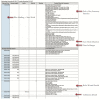A Review of Continuous Glucose Monitoring Data Interpretation in the Age of Automated Insulin Delivery
- PMID: 31130007
- PMCID: PMC6610610
- DOI: 10.1177/1932296819851790
A Review of Continuous Glucose Monitoring Data Interpretation in the Age of Automated Insulin Delivery
Abstract
Using a continuous glucose monitor (CGM) improves glycemic control in patients with type 1 diabetes. The ambulatory glucose profile (AGP) has been recommended as a standard method for reporting CGM data. However, in recently developed automated insulin delivery (AID) systems, a standard format for reporting data has not yet been developed. Instead, reports are specific to each system being used. Currently, the only FDA approved AID system is a hybrid closed-loop insulin pump. In these systems, the patient is still required to announce a meal, respond to alerts, and keep the system in automated insulin delivery. The integrated pump and sensor information provides insights into how the system is performing, and how to make changes to tunable parameters, such as carbohydrate to insulin ratios. The reports also offer a window into human behavior related to performing diabetes tasks, responding to alarms, reasons for exiting HCL, and how glycemic goals are being met. This article reviews the pump and CGM data provided by several of the current closed-loop systems with a focus on systems that are currently approved in the United States (MiniMed™ 670G, Tandem Basal:IQ) and those used by patients using do-it-yourself systems. A step-wise approach to reviewing the nuances of these systems is provided. The comparison may reinforce the importance of the continued need for streamlining a standard report for providers to be able to interpret the CGM data of these systems.
Keywords: MiniMed 670G; Tandem Basal IQ; closed loop; continuous glucose monitoring system; do-it-yourself; type 1 diabetes.
Conflict of interest statement
Figures


















Similar articles
-
Cost-Effectiveness Analysis of the MiniMed 670G Hybrid Closed-Loop System Versus Continuous Subcutaneous Insulin Infusion for Treatment of Type 1 Diabetes.Diabetes Technol Ther. 2019 Mar;21(3):110-118. doi: 10.1089/dia.2018.0328. Epub 2019 Feb 20. Diabetes Technol Ther. 2019. PMID: 30785311
-
Continuous Glucose Monitoring: A Review of Recent Studies Demonstrating Improved Glycemic Outcomes.Diabetes Technol Ther. 2017 Jun;19(S3):S25-S37. doi: 10.1089/dia.2017.0035. Diabetes Technol Ther. 2017. PMID: 28585879 Free PMC article. Review.
-
INTEGRATED INSULIN PUMP AND CONTINUOUS GLUCOSE MONITORING TECHNOLOGY IN DIABETES CARE TODAY: A PERSPECTIVE OF REAL-LIFE EXPERIENCE WITH THE MINIMED™ 670G HYBRID CLOSED-LOOP SYSTEM.Endocr Pract. 2018 Jul;24(7):684-692. doi: 10.4158/EP-2018-0097. Endocr Pract. 2018. PMID: 30048171 Review.
-
The Effect of Prior Continuous Glucose Monitoring Use on Glycemic Outcomes in the Pivotal Trial of the MiniMed™ 670G Hybrid Closed-Loop System.Diabetes Technol Ther. 2017 Dec;19(12):749-752. doi: 10.1089/dia.2017.0208. Epub 2017 Nov 17. Diabetes Technol Ther. 2017. PMID: 29148821 Clinical Trial.
-
Switching from Suspend-Before-Low Insulin Pump Technology to a Hybrid Closed-Loop System Improves Glucose Control and Reduces Glucose Variability: A Retrospective Observational Case-Control Study.Diabetes Technol Ther. 2020 Apr;22(4):321-325. doi: 10.1089/dia.2019.0302. Epub 2020 Feb 11. Diabetes Technol Ther. 2020. PMID: 31617752
Cited by
-
Molecular Research on Diabetes.Int J Mol Sci. 2025 Feb 21;26(5):1873. doi: 10.3390/ijms26051873. Int J Mol Sci. 2025. PMID: 40076500 Free PMC article.
-
Personalization of continuous glucose monitoring system for diabetic patients in the Polish market in 2024.Pediatr Endocrinol Diabetes Metab. 2025;31(2):75-79. doi: 10.5114/pedm.2025.152598. Pediatr Endocrinol Diabetes Metab. 2025. PMID: 40755346 Free PMC article. Review.
-
Top 10 Tips for Successfully Implementing a Diabetes Telehealth Program.Diabetes Technol Ther. 2020 Dec;22(12):920-928. doi: 10.1089/dia.2020.0042. Epub 2020 Apr 21. Diabetes Technol Ther. 2020. PMID: 32191141 Free PMC article.
-
Remote Patient Monitoring in Diabetes: How to Acquire, Manage, and Use All of the Data.Diabetes Spectr. 2022 Feb 15;35(1):43-56. doi: 10.2337/dsi21-0015. Epub 2022 Feb 8. Diabetes Spectr. 2022. PMID: 35308161 Free PMC article.
-
Advancing Digital Solutions to Overcome Longstanding Barriers in Asthma and COPD Management.Patient Prefer Adherence. 2023 Jan 28;17:259-272. doi: 10.2147/PPA.S385857. eCollection 2023. Patient Prefer Adherence. 2023. PMID: 36741814 Free PMC article. Review.
References
-
- Diabetes Control and Complications Trial Research Group, Nathan DM, Genuth S, et al. The effect of intensive treatment of diabetes on the development and progression of long-term complications in insulin-dependent diabetes mellitus. N Engl J Med. 1993;329:977-986. - PubMed
-
- Beck RW, Tamborlane WV, Bergenstal RM, et al. The T1D Exchange clinic registry. J Clin Endocrinol Metab. 2012;97:4383-4389. - PubMed
-
- Cryer PE. Hypoglycaemia: the limiting factor in the glycaemic management of type i and type ii diabetes. Diabetologia. 2002;45:937-948. - PubMed
Publication types
MeSH terms
Substances
Grants and funding
LinkOut - more resources
Full Text Sources
Other Literature Sources
Medical
Miscellaneous

